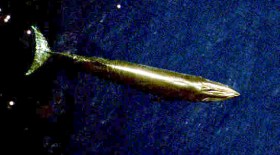Bryde's Whale (Balaenoptera brydei) - Wiki Bryde's Whale
From Wikipedia, the free encyclopedia
[Photo] Bryde's Whale (Balaenoptera brydei). U.S. National Marine Fisheries Service photo by Wayne Hoggard.
Bryde’s Whales are the least-known and in many ways the most unusual of the rorquals. They are small by rorqual standards???no more than about 25 tonnes???prefer tropical and temperate waters to the polar seas that other whales in their family frequent; are largely coastal rather than pelagic, and although they retain the characteristic plates of whalebone that the baleen whales use to sieve small creatures from the waters with, their diet is composed almost entirely of fish.
"Bryde's" is pronounced "broo-dess", and the name is sometimes mistaken as "brutus whale". The Bryde’s whale got its name from Norwegian consul to South Africa, Johan Bryde, who helped set up the first whaling factory in South Africa in the early 1900s.
The whale is also called Luulumbo by the Kadazans in Sabah, Malaysia.
Bryde’s whales feed on pelagic schooling fish, such as anchovy and herring.
They are distributed widely throughout tropical and subtropical waters, with a separate, smaller, pygmy species found in tropical Western Pacific and South-East Asia.
Anatomy
In general, Bryde's Whales have a very broad and short head, with between 40 and 70 ventral grooves, and relatively large eyes.
The Bryde’s whale is a baleen whale and is unique in that it has three longitudinal ridges on its head, from the tip of the snout back to the blowhole. (The other rorquals have just one ridge.)
According to International Fund for Animal Welfare, the mammal has folds or grooves on its throat and chest that allow the mouth to expand when filled with water.
The whale has twin blowholes with a low splashguard to the front. It has no teeth but has two rows of baleen plates.
The prominently curved, pointed dorsal fin is readily seen when a Bryde's Whale surfaces. The flippers are small and slender; the broad, centrally notched tail flukes never break the surface.
Colour varies: the back is generally dark grey or blue to black, the ventral area a lighter cream, shading to greyish purple on the belly. Some have a number of whitish-grey spots, which may be scars from parasites or shark attacks.
Distribution
Specific occurences
On August 23, 2007, a large whale with wounds in several parts of its body was found dead in waters off the town of Tagdon, Barcelona in Sorsogon province in the Philippines. The 14-meter long, 7-ton corpse was later identified to be a Bryde's whale. This particular species is known to frequent the coastal waters of the central Philippines, specifically the waters off Siquijor, Bohol, Palawan and Camiguin.
Life history
Bryde’s whales are believed to breed year round and their gestation period is estimated to be 12 months. Calves are about 4 m long at birth and weigh 1,000 kg.
Taxonomy
There appear to be two species, and some confusion between them exists. Bryde's Whales are very similar in appearance to Sei Whales and almost as large, and were not described until 1878 from a stranded specimen on the coast of Burma, which was given the name Balaenoptera edeni. In 1913 whales off the coast of South Africa were described as Balaenoptera brydei, the name being given to honour Johan Bryde, Norwegian consul and pioneer of the South African whaling industry.
By the 1950s, it was thought that they were a single species, which became B. edeni (because the first proposed name for any species always has priority) but retained Bryde's Whale as the common name. Recent genetic work, however, indicates that there are in fact two separate species:
Bryde’s Whale, Balaenoptera brydei, with a worldwide tropical and semi-tropical distribution, grows to 26 tonnes and 15 metres long.
The Pygmy Bryde's Whale (still often called Eden's Whale, Balaenoptera edeni), is found in coastal waters of the eastern Indian and western Pacific oceans.
Bryde's whales vary considerably in form. Five different types have been identified, including at least two smaller ones that tend to stay closer inshore. Alas from the point of view of taxonomic simplicity, DNA testing shows that the newly confirmed pygmy species of South-east Asia is not the same as the similar-looking small form found in the Caribbean. Complicating matters still further, there are forms which appear to be intermediate between Bryde's Whale and the Sei Whale. See also Balaenoptera omurai.
Conservation
Bryde’s whale is listed as Data Deficient by the International Union for the Conservation of Nature and Natural Resources (IUCN). It is also listed on Conservation on International Trade of Endangered Species of Wild Fauna and Flora (CITES) Appendix I, which prohibits international trade.
http://en.wikipedia.org/wiki/Bryde%27s_Whale
| The text in this page is based on the copyrighted Wikipedia article shown in above URL. It is used under the GNU Free Documentation License. You may redistribute it, verbatim or modified, providing that you comply with the terms of the GFDL. |
